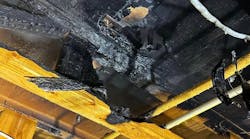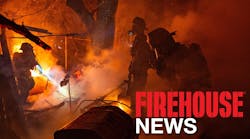Fire officials in the State of Guanajuato in Mexico have a belief that the best fire department isn't the one that responds to the most calls. Rather, it's the one that prevents the most fire.
A new "best practices" report shows virtually the entire world does a far better job at reducing fire causalities than the United States by as much as 50 percent in some cases.
The final installment of a three-year study examining how 10 nations handle fire prevention in their countries was recently released. The report, commissioned by the U.S. Centers for Disease Control and Prevention (CDC), was researched and written by System Planning Corporation's TriData Division in Arlington, Va. The principal researcher was TriData's president Philip Schaenman.
"It's not that other nations are doing anything that we haven't tried, it's just that the scale in which they do it is just spectacular compared to what we do here in the United States," said Schaenman, who in the late 1970s and early 1980s, served as the U.S. Fire Administrator in charge of the National Fire Data Center.
"Unfortunately, our fire service has not been excited about prevention."
But that, Schaenman says, has to change if the U.S. is serious about its commitment to reduce fire fatalities. Other developed nations have figured it out and devote extraordinary resources to home inspections, fire prevention instructions to all populations, and requiring line firefighters to take on the role of fire prevention as part of their daily duties.
The report, totaling more than 300 pages, was rolled out in three parts since 2007. Part I looks at best practices in Europe (England, Scotland, Sweden and Norway). Part II examines innovations in the Asia/Pacific region (Australia, New Zealand and Japan). And the third and final part studied North America (Canada, Mexico, the Dominican Republic and Puerto Rico). The complete study is available for download at System Planning Corporation's Web site.
Since the report has been available, it's been downloaded 12,000 times, according to James M. Kudla, System Planning Corporation vice president of communications.
One of the most exciting things about the report, according to Schaenman, is that the best practices identified could help reduce fire deaths and injuries in the U.S. at little or no additional cost. Education and one-on-one instruction by firefighters is a top factor in reducing fire deaths, he said.
By way of example in England, British firefighters went on strike in 2003 demanding a 40 percent pay increase, Schaenman said. During the strike, ironically, the number of fires and fire deaths dramatically reduced, he said, because people were extremely careful.
"It proved that fire education worked," Schaenman said. "It proved the wrong thing for them, but it was very interesting."
For the British negotiating with the firefighters, it gave them the opportunity to push the rank and file into fire prevention. Schaenman said the firefighters were offered a 17 percent raise with the understanding the rank and file were going to have to do more "white collar" fire prevention work.
"Fire prevention became part of their job," he said.
Schaenman said firefighters in the U.S. should start embracing fire prevention as a key part of their jobs and not try to shift the responsibilities or, worse avoid them. He recalls the fire service's resistance to providing emergency medical services 20 to 30 years ago and the number of firefighter jobs that were lost as a result.
"We're going to have to reduce some of the work load we expect of firefighters and increase other duties," he said. "There are a lot of best practices that are doable here and doable without any increase in cost."
Some firefighters in Canada are required to do fire prevention field work two hours of every day, doing home inspections with the goal of visiting every home in their district every five years. Initially, those firefighters balked at the requirement, but soon realized the importance of the work and began to enjoy it, he said.
Another big trend Schaenman discovered was developed nations partnering with social service agencies, such as Meals on Wheels and similar organizations that have people in homes of high risk populations, like the elderly.
"They're in touch with the real shut-ins, the high risk populations," he said. Those agencies report to the fire departments hazards and unsafe conditions for fire department intervention before fatal fires occur.
The report reveals that kids in Mexico learn about fire prevention with the help of music, and "The Rapping Firefighter" helps teach students.
"It turns out students in Mexico learn their lessons better with a dose of Salsa," Schaenman said.
There are some technological best practices out there too that help prevent fire deaths, he said.
In Scandinavia, the wicks in candles don't go all the way to the bottom, which essentially makes for self-extinguishing candles that burn out before they completely liquefy and cause fires, he said.
Unattended food burning on a stove is another leading cause of fatal fires and, Schaenman said there are devices in Europe that require the user to set a timer for 10 to 15 minutes before using the stove. The electric cooking appliance automatically turns off when the timer runs out, requiring it to be rest for additional cooking.
For the very high risk elderly and shut-ins who may have physical disabilities that make it difficult to evacuate in the event of fires, Europeans have portable temporary sprinkler systems that can be installed in the person's home for $2,000 to $3,000. When the person dies of natural causes, or moves, the system can be installed in another person's home for protection, he said.
In Vancouver, British Columbia, there are laws that all new residences must have sprinklers and any building that's 50 percent or more remodeled must also be fitted with sprinklers. The result is that more than half of the homes in the district now have sprinklers in the 19 years since the law was adopted.
"That is just spectacular," Schaenman said, noting that it took 10 years to pass the legislation.
Other highlights from the report include information about mobile home safety fire vans used in Australia and New Zealand that have compartments simulating rooms in a home to show fire safety issues in each area.
Ontario, Canada has a Zero Tolerance philosophy toward property owners and tenants who do not install and maintain smoke alarms on each story. Non-compliance can result in citations, like traffic tickets, with fines up to $235.
In Mexico, fire and life safety messages with bright colors and pictures are printed on milk cartons for kids to easily receive the attractive message. And candles, which are widely used on home altars and left burning for long periods of time, have been converted to battery-powered candles with fire officials' promoting their use.
In Japan, education is the key component to fire safety, and the report concludes that the Japanese have perhaps the most extensive fire safety education program among developed nations.
And Schaenman is convinced that education, provided by the rank and file firefighters, is the most effective tool the U.S. has to reduce fire causalities in the nation.
There are literally hundreds of ideas in the report -- some are familiar in the U.S. and others are brand new, but the volume and emphasis found in other developed nation is overwhelming by comparison. And the reduction in fire causalities is a reflection of the effort.
"Much of what we found can be adapted to the United States," Schaenman said. "It may take changing the fire service culture a little bit in some places to incorporate the new practices, as it has in other nations, but some of these practices are already in use here, though not on the scale as in cities abroad."
Schaenman, who has been studying and researching the fire service for more than three decades, is convinced that real progress in fire safety can be made in the United States by implementing the best practices found around the world.
"We can save many lives in the United States over the next five years if we adopt the best practices proven in other nations," he said. "We would recommend that major fire organizations consider promoting the implementation of best practices because they can save citizens' lives and help reduce fire service casualties."
Related for Fire Prevention Week 2009:
- Maryland County Releases Fire Sprinkler Study
- Vote on Sprinkler Mandate Later This Month
- Illinois Dept. Delivers Prevention With Pizza
Related Study:
Other Related Stories:





